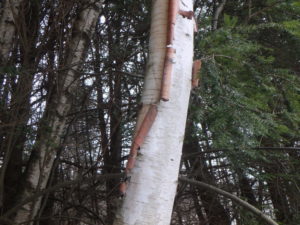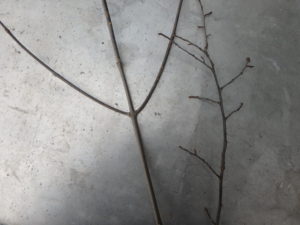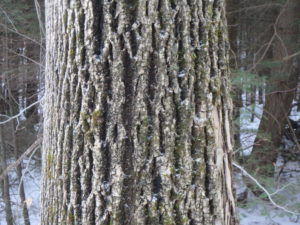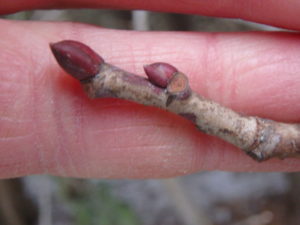Identifying Trees in Winter
Despite their lack of leaves in winter, it really is not too difficult to identify most trees now. You just have to look at other characteristics such as branching patterns, bark, overall shape, seeds or fruit, where they grow, and what their buds look like. I recently went to Goffstown, NH to attend a workshop on tree I.D. in winter run by forester Ethan Belair of UNH Cooperative Extension. It was worth the trip across the state to attend.
For mature trees, I tend to use the overall shape and branching patterns to identify trees in winter. Sugar maple? White pine? Hemlock? I can generally identify those from a distance while in a moving car just by their shape. But for young trees it is harder, particularly for trees that are less common.
According to Ethan Blair, bark is the best way to identify trees. Summer or winter, if you know the look of a tree’s bark, you can identify it. It takes practice, of course, and careful observation.
Some bark is very distinctive. Beech (Fagus grandifolia), for example, has a smooth gray bark that you can learn in moments. I love to run my hands over the bark, as if petting an elephant. (And yes, I have hugged trees on occasion). Young beech, particularly, hold onto their leaves in winter, which is also a good clue.
Many beech trees now are marked by a fungus that produces cankers, blackening and open wounds. It will eventually kill infected trees, and ruins that gorgeous bark.
Most everyone can identify white or paper birch (Betula papyrifera) by its white, peeling bark that is easily removed from a tree by enthusiastic Boy or Girl Scouts anxious to start campfires fires. I learned from Belair that emoving the bark by hand will not hurt the tree, though you should never use a knife or ax to do so, as you can hurt the tree.
Gray birch (B. populifolia) is similar to white birch, but it does not peel like its cousin, and has a dirtier look. Yellow birch (B. alleghaniensis) peels like white birch but is a golden or silvery gray color.
But did you know that young white birch are not white at all? They have a deep reddish black color and are spotted with small white dots or short white lines, lenticels, that feel rough if you rub your hand over them. Eventually, after 7 or 8 years, white birch saplings will start to turn white.
Branching patterns help to identify trees at any time of the year. Most species of trees and shrubs have what is called alternate branching. That means that as your eye follows a branch, the twigs and leaves alternate from one side to the other. A limited number have opposite branching with twigs facing each other across a branch. Of course – just to confuse us – sometimes twigs or leaves have broken off on a tree like a maple that should have opposite branching.
There is a mnemonic for trees that have opposite branching: MAD Cap Horse. Translated, that means maple, ash, dogwood, member of the Caprfoliacea family (honeysuckle, viburnum and elderberry, among others) and horse chestnut. So if you see opposite branching, you can eliminate lots of possibilities.
Where a tree appears in the forest is a clue, too. Some trees need lots of light, while others do fine in shade – the understory. Of the understory plants, beech is one, basswood, yellow birch and hemlock are others.
Poplars, in contrast, show up in open fields after clear cutting or a fire. Their branches reach upward, as if trying to grab the sun. They are short-lived trees that die out in 30 or 40 years – about the time they are shaded by canopy trees like maples, oaks or ash.
White ash is an easy tree to identify by bark: it has prominent ridges with deep furrows. It is dark brown or deep gray. Unfortunately this wonderful tree will probably disappear from our woodlands due to a foreign invader: the emerald ash borer. Ethan Belair suggested cutting down white ash trees now, before they succumb to the blight.
Buds at the end of a branch are another distinctive characteristic. Red maple (Acer rubrum) and sugar maple (A. saccharum) can be distinguished by their buds, for example. Sugar maple terminal buds are sharp and pointy, red maple buds are blunt and reddish in color, especially as we approach spring. Sugar maple buds are grayish or purplish-brown.
Last spring while hiking in the woods I spotted a tree with bright red buds that I couldn’t identify right away (it stumped me!). It was a basswood or American linden (Tilia americana), which is a native relative of a European shade/street tree called the little-leafed linden (Tilia cordata). I am at the northern limit of basswood, but in Goffstown where the workshop was held, it was common. So I got to see mature specimens. Their branches reach out and often bend down; they often they grow in clumps. Belair said they are “locally common, regionally rare.”
One of my favorite guides to trees is spiral-bound, water-resistant guide written by a Trevor Evans, Forest Trees of Vermont. It even comes with ruler and magnifying glass!
So if you are bored being indoors this winter, get outdoors and learn your trees!
Henry is a UNH “lifetime” Master Gardener and the author of 4 gardening books. Read his blog at https://dailyuv.com/gardeningg






